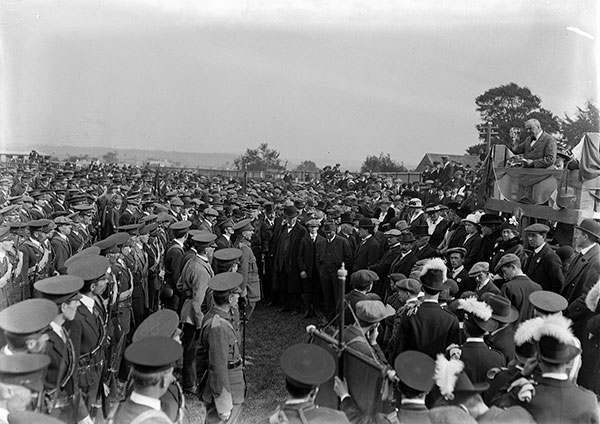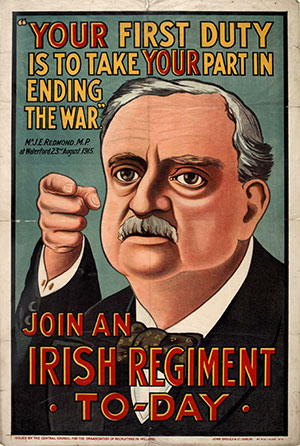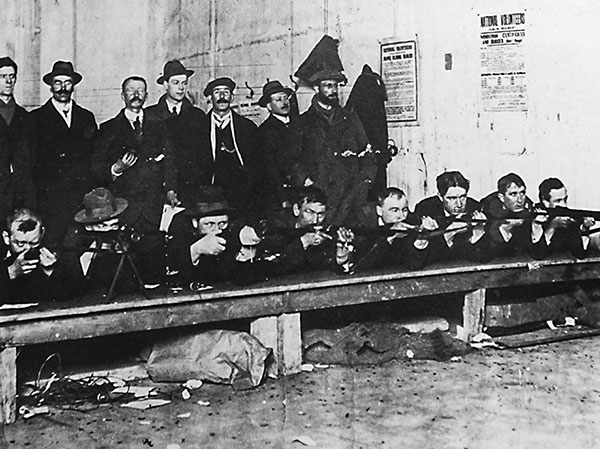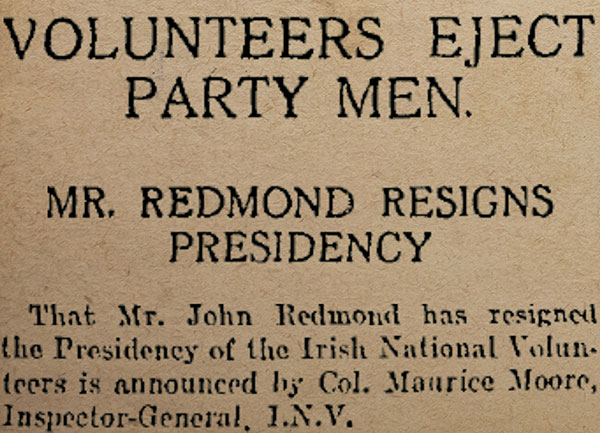What happened to Redmond’s National Volunteers?
Published in Features, Issue 1 (January/February 2018), Revolutionary Period 1912-23, Volume 26The National Volunteer movementwas the largest paramilitary force in Ireland in the autumn of 1914, numbering an estimated 158,360 men.What happened to it?
By Shane Brown
In 1972 Robert Kee emphasised that ‘for a time, even at home, the Redmond National Volunteers remained strong and active… putting the activities of the small body of obscure secessionists into the shade’. This activity culminated in the Easter review at the Phoenix Park on 4 April 1915, when an estimated 27,000 men paraded in companies from all four provinces. At their first convention the following day,the National Volunteer movement consisted of 817 registered companies,representing between 120,000 and 150,000 men.Yet despite its size and significance, the movement still awaits a dedicated history.
Owing to the haemorrhaging of their best men to the British army,and the inability to arm the movement across the country, the organisation succumbed to slow paralysis. The 1915 Easter review was the movement’s high-watermark,and by September 1915 the organisation’s inspector-general, Col. Maurice Moore, felt that nothing could be done with the Volunteers. He candidly explained to John Redmond that ‘they cannot be trained, disciplined or armed’. While this was a bleak assessment, Moore remained committed to the failing movement. The key question after the 1916 Rising was not whether but how the organisation would be carried on.
After the Rising
In the aftermath of the 1916 Rising, martial law was extended across Ireland. Drilling was suspended, and political meetings, parades and processions were prohibited. While Moore had hoped that the National Volunteers would ‘form a rallying point because the military authorities were not inclined to suppress them’,General Sir John Maxwell was opposed to any plans tore-establish the organisation. He rejected Moore’s plea to allow the movement to carry out private drilling and shooting practice, even after Moore was pressed to remind him that ‘the Volunteers will not consider that they are well rewarded for their loyalty during the rebellion by being practically suppressed afterward’.
Maxwell and the authorities were wary of showing any leniency, and alarm bells rang in July 1916 when a document signed by Moore and Laurence J. Kettle called on the National Volunteers to support the Irish National Aid Association (INAA). The INAA had been organised to provide for the relatives of imprisoned men and the families of those sentenced to death after the Rising, and the wording of the appeal worried Maxwell. National Volunteer members were told ‘to do something more than mourn … [and] remember that their fellow countrymen fought bravely and died in what they believed to be a just cause’. Moore was also firmly pushing for another convention to formally reorganise the movement, which exacerbated the already heightened tensions.
Need for a convention

Above: John Redmond addressing a review and presentation of colours to the Waterford Battalion, National Volunteers,c. 1914. At that stage the movement was the largest C force in Ireland, with an estimated 158,360 men. (NLI)
Under the constitution of the National Volunteers, a convention was to be held at least once every two years. Consequently, by 22 August 1916 the national committee was planning ‘to arrange for and summon a National Convention at the earliest possible date’.This was proposed at a special meeting of the committee on 12 September, but their rhetoric panicked Redmond and the authorities. The National Volunteers were to be put ‘on a sound and permanent fighting footing… [and] in the interests of the nation every man must stand to arms’. Statements such as these were treading on dangerous ground. With tensions fraught owing to the recent execution of Roger Casement, such rhetoric was tantamount to inciting rebellion.

Above: Inspector-General of the National Volunteers Col. Maurice Moore at the Phoenix Park for the Easter review on 4 April 1915, the movement’s high-watermark.
When the national committee finally met to discuss Redmond’s views on 14 November,John T. Donovan, a loyal Redmondite on the committee,wrote to Redmond and explained that the Volunteers were not shaping up too well and some IPP supporters were in agreement ‘that if [something] practical were not done … thousands of young men all over the country would drift into secret societies’. He also warned that Moore was planning to resign his position on the committee and go public with his grievances if a convention was not scheduled. Moore’s efforts seemed absurd to Donovan,who felt that it was impossible to hold a representative national convention with just 30 companies now affiliated to the national committee.
Republican infiltration
The debate dragged on into 1917 but,unbeknownst to Moore, two of his key supporters,Captain Laurence Nugent and Major T.J. Cullen, were now in daily communication with the republican activist Rory O’Connor. Nugent recalled that there were seven men working behind the scenes on the National Volunteer committee in the interests of the republican movement. They were‘now enmeshed in the stark reality of secret service’ and utilised Moore’s position ‘to know every move the British military intended to make’.
In opposition to Nugent’s subversive faction, the IPP loyalists were also behaving surreptitiously. In a letter to Redmond on 7 February 1917, Donovan explained that he was aware of ‘four or five on the committee who aim at creating mischief’. While he felt that Moore was not acting with ulterior motives, he enlightened Redmond to the fact that Nugent and Cullen had canvassed in North Roscommon for the republican candidate, Count Plunkett. Donovan also explained that at a meeting of the national committee on 6 February 1917 Stephen Hand, an IPP loyalist,had proposed that a convention be held on Easter Monday, 9 April 1917, with the express hope that ‘the Authorities would prohibit it being held on that date having regard to the fact that the Rebellion occurred on last Easter Monday’. This ruse backfired, however, when Redmond perceived the motion—which had been carried by thirteen votes to four—as an open defiance of his leadership. On 13 February 1917 he contacted the honorary secretaries and signalled his intention to resign as president of the National Volunteers.
In an effort to appease the IPP leader, Donovan promised that, with Joe Devlin’s help, they could whip up their friends and ‘clinch the matter once [and] for all, even at the expense of Moore’s resignation’. A fractious meeting of the national committee commenced on 20 March and, in a vote of sixteen to nine, Donovan succeeded in quashing the proposed convention once more. He informed Redmond of their success, but warned that Moore might now carry out his threat of going to the press.
Moore goes public

Above: Redmond’s image as a recruiting sergeant for the British Army has permeated popular collective memory, but less than 25,000 National Volunteers actually joined Crown forces, just 15% of their original strength.
In response to these hammerings, Patrick Rooney, a treasurer of the movement and a loyal Redmondite, sought to clarify the gravest charges expressed by anonymous members of the National Volunteers. He asked the editor of theIrish Independent: ‘Have you convinced yourselves that these gentlemen are concerned only for the welfare of the Volunteers?’Intriguingly, these anonymous figures were in fact members of the subversive republican faction working behind the scenes in the National Volunteers. Laurence Nugent and others were actively pursuing a policy of subterfuge. Nugent later stated that during this time they were receiving ‘large space in the public press… principally in the Independent’, and he caustically revealed that their stand ‘was definitely for the welfare of the Volunteers, but not for the Volunteers as Mr Rooney or the IPP visualised them’.

Above: National Volunteers training for their marksmanship certificates c. 1914–15. With the implementation of martial law after the 1916 Rising, drilling and indoor training such as this was suspended. (NMI)
Throughout the summer of 1917 the national committee remained divided. With Irish Party loyalists remaining stoic in their opposition, the situation came to a dramatic conclusion on 17 July 1917. Members of the National Volunteers nominally loyal to Moore but secretly led by the republican faction under Nugent and Cullen seized National Volunteer headquarters at 44 Parnell Square, Dublin. Nugent remembered that ‘the seizure of the hall was well planned … [and] in cooperation with the Irish Volunteers Executive’. Writing to the press on 20 July, Moore now hoped that the holding of a convention would heal the split that ‘caused so serious a damage to the Volunteer organisation three years ago’.
The long-deferred convention finally took place on 5 August 1917. Represented were 176 companies from nineteen counties, with Moore claiming that it had taken just three weeks to affiliate these companies after the national committee had been bypassed. Unbeknownst to Moore, however, Nugent and Cullen had packed the convention, having used the National Volunteer register to contact companies long since dormant.

Above: On 17 July 1917 Maurice Moore and those loyal to him seized National Volunteer headquarters at 44 Parnell Square and declared that the national committee’s tenure was over. (Irish Independent)
Rival conventions
The Redmondite loyalists denounced the convention, stating that it ‘was irregular and at variance with the constitution in almost every particular’.Nonetheless, Moore was adamant that this was the correct step to take. Angrily stating his position in a letter to Monsignor Arthur Ryan, a trustee of the movement, he proclaimed that the stifling nature of the national committee and their continued obstructions had led him to make this call. He explained that he only took this final step when he found ‘that no inducement could make those who had the controlling influence in the [Volunteers] call a Convention… Win or lose in law, the party, and MrR[edmond] personally, will be ruined, not in a political sense alone but as a reliable person’. At the convention Moore expressed his desire ‘to unite the Volunteers in Ireland as they were united in 1913 and 1914’.
Although Moore’s association with the National Volunteer movement was now at an end, the Redmondite loyalists refused to accept the legality of the 5 August convention.They held their own in the Mansion House on 28 September 1917, but newspaper reports recorded that less than 60 men were in attendance, highlighting ‘the dwindling support accorded to the Party adherents’. Nevertheless, the reorganised committee remained intact throughout 1917 and, on 11 November 1917, the Freeman’s Journal reported that a ‘largely-attended and representative meeting of the National Committee was held’. Reorganisation, it was claimed, was ‘progressing satisfactorily all over the country’. This was probably an exaggeration, but thereafter the committee did continue to meet, and affiliated companies in Limerick and Galway, amongst others, remained loyal. The conscription crisis in April 1918 also saw Redmondite National Volunteer companies become active again in various counties.
Conclusion
The demise of Redmond’s National Volunteers clearly was more complex than has been previously detailed. The National Volunteers’ motto of ‘Defence not defiance’ did not fit with the narrative of the Irish nation after 1922. The general trend in the historiography has been to treat the National Volunteers as a footnote in a teleological narrative leading to the 1916 Rising. Writing for History Ireland recently, Conor Mulvagh posed the question: when did Redmond’s supporters finally discover that Redmondism had become unpalatable? Thus far this question has not been answered, but what is certain is that constitutional nationalism did not simply vanish amidst the ruins of Dublin in Easter Week 1916. An all-Ireland study of the National Volunteers is therefore important in tracing the post-1916 shift in allegiance from Redmondism to separatism.
Shane Browne is a Ph.D studentat University College Dublin.
FURTHER READING
- M. Laffan,The resurrection of Ireland: the Sinn Féin Party 1916–1923(Cambridge, 1999).
- D. Ó Corráin, ‘“A most public spirited and unselfish man”: the career and contribution of Colonel Maurice Moore, 1854–1939’,Studia Hibernica (2014).
- M. Wheatley,Nationalism and the Irish Party: provincial Ireland 1910–1916(Oxford, 2005).
















